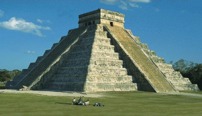
 pyramid
is a tetrahedron. May refer
to something such as one of the massive
monuments of ancient Egypt having a rectangular
base and four triangular faces rising to a single point, built
over or around a tomb or crypt. May refer to various similar construction, including a four-sided
Mayan temple having stepped sides, surmounted by ceremonial chambers
upon a level platform, or the ziggurats
of the ancient Assyrians and Babylonians.
pyramid
is a tetrahedron. May refer
to something such as one of the massive
monuments of ancient Egypt having a rectangular
base and four triangular faces rising to a single point, built
over or around a tomb or crypt. May refer to various similar construction, including a four-sided
Mayan temple having stepped sides, surmounted by ceremonial chambers
upon a level platform, or the ziggurats
of the ancient Assyrians and Babylonians.
Examples of pyramids:

Egypt, El Giza, Great
Pyramid also known as "Pyramid of Cheops" or
"Khufu's Pyramid" (tallest of the three pictured),
2600-2480 BCE,
bearing masonry
(cut stone), 756 feet square in plan,
and 481 feet (153 meters) high. The square
of its height equals the area of each triangular face, as determined
by Herodotus in 450 BCE.
The base of the pyramid covers about 13 acres. The pyramids at
Giza are descendants of earlier stepped designs
which were built in superimposed layers. They are gigantic prisms unique in world architecture. To build the
Great Pyramid it took an about 2,300,000 dressed stone blocks
(averaging 2.5 tons each) -- more than any other structure
ever built. Contemporary
Egyptologists think the blocks were moved on log rollers and
sledges, and then ramped into place. It is considered one of
the Seven Wonders of
the Ancient World. See Egyptian
art.

Mayan, El Castillo, pyramid at Chichen Itza,
Yucatan Peninsula, Mexico, c. 9th century. See Mesoamerican
art and Pre-Columbian art.
I. M. (Ieoh Ming) Pei (American, 1917-) , Pyramid of the Louvre, 1989, the art museum entrance, constructed of glass, steel rods and cable. This photo: looking through an arch in the museum building toward the pyramid in its courtyard (the "Cour Napoleon").

Jackie Ferrara (American, 1929-), Stacked
Pyramid, 1972, cotton batting with glue on wood,
24 x 52 x 13 inches (61 x 132.1 x 33 cm), Museum of Contemporary
Art, Chicago, IL.
Keith Haring (American, 1958-1990), Untitled, 1982, sumi-e ink on paper, 19 1/2 x 27 1/2 inches, private collection.
Also see ben-ben, mathematics, polygon, Seven Wonders of the Ancient World, and tetrahedron.
https://inform.quest/_art